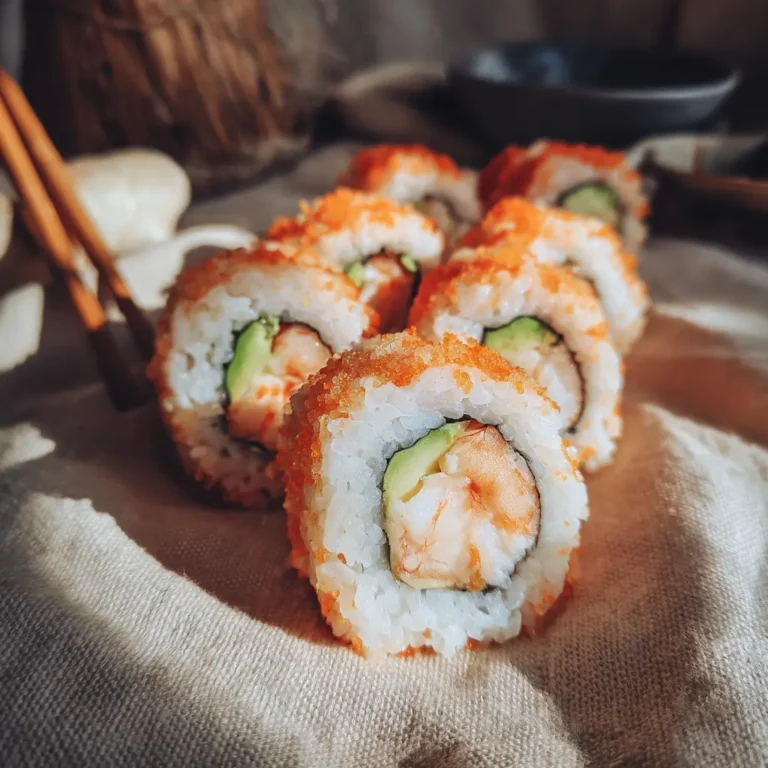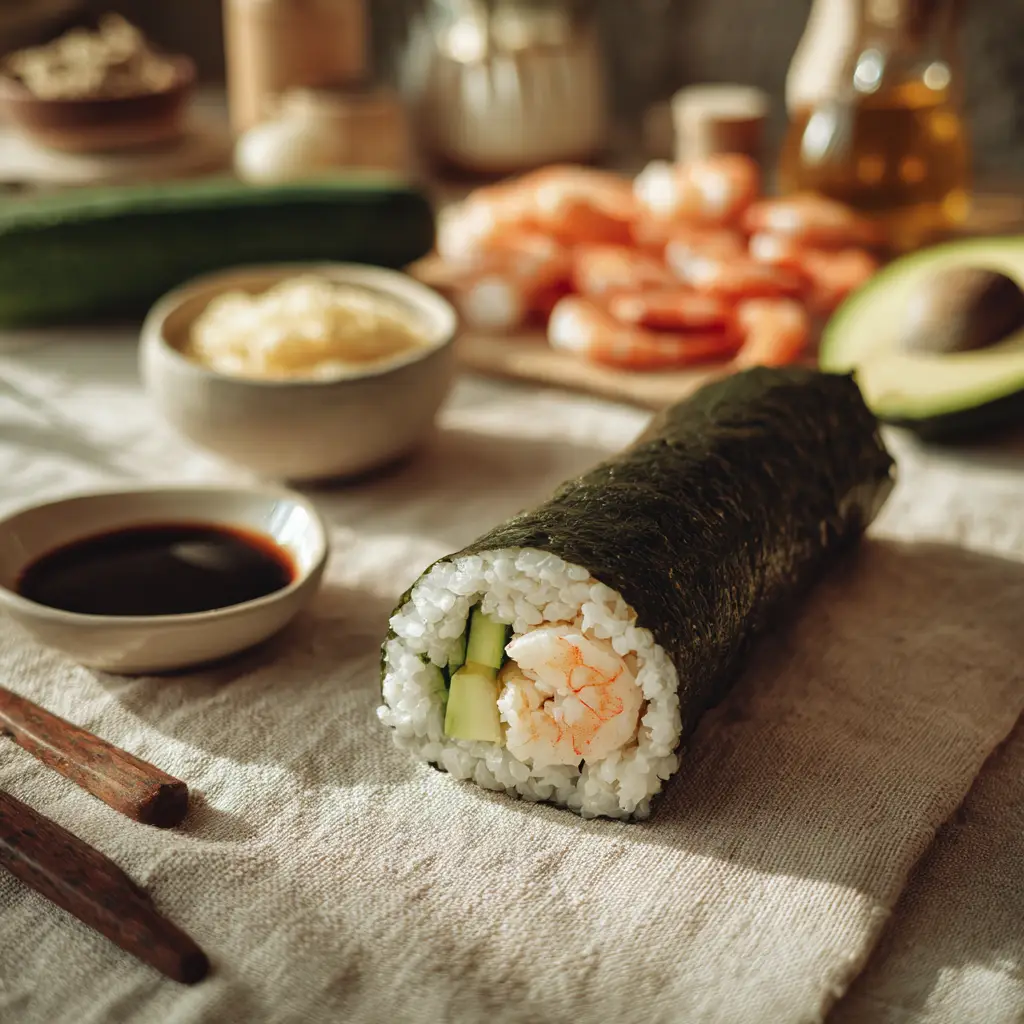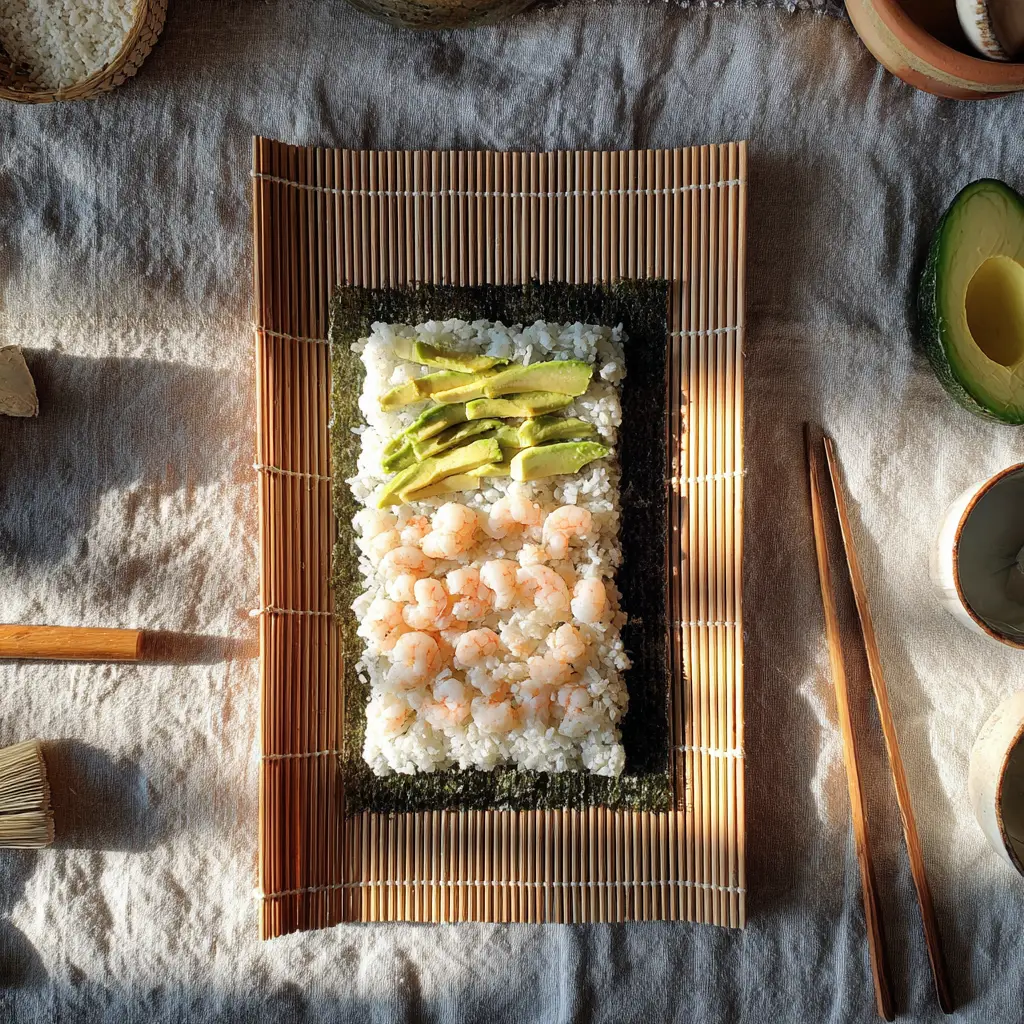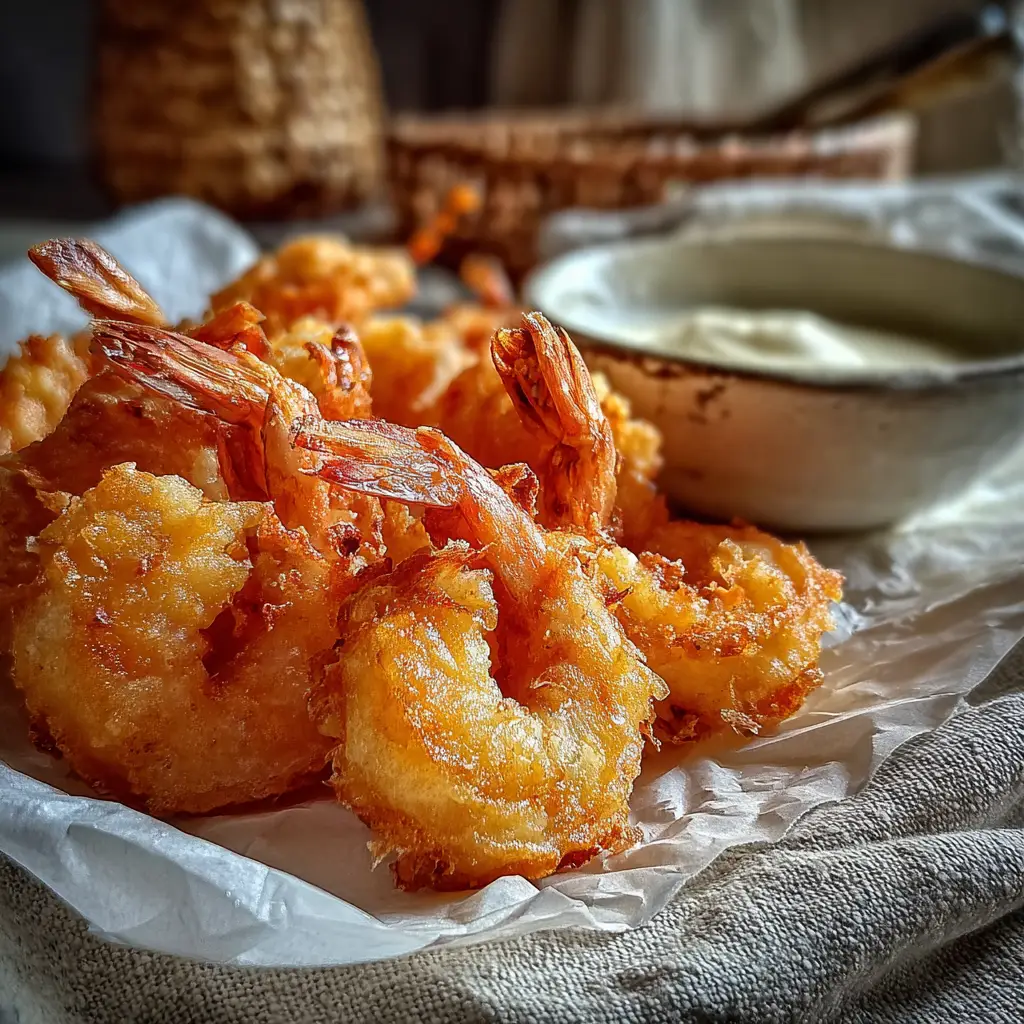Introduction
The shrimp tempura roll is one of the most beloved items on any sushi menu—and for good reason. With its perfect balance of crispy fried shrimp, creamy avocado, sticky rice, and nori, it delivers a flavor and texture explosion in every bite. Whether you’re a sushi beginner or a seasoned sushi lover, the shrimp tempura roll (sometimes called a tempura shrimp roll or shrimp tempura sushi roll) is often the go-to choice when you’re craving something familiar yet indulgent.
But what exactly makes a crunchy shrimp tempura roll so popular? Is it cooked or raw? Is it healthy? What about the shrimp tempura roll calories—should you be worried? And can you really make this at home with restaurant-quality crunch?
In this complete guide, we’ll break down everything you need to know about the shrimp tempura roll—from its ingredients and origins to its nutritional content and preparation. You’ll also learn how it differs from traditional sushi, what “tempura” actually means, and whether it’s a smart choice for your diet.
Discover great ideas like how to choose quality shrimp from your local market to level up your sushi night at home. Whether you’re looking for calorie counts or DIY tips, this article gives you everything you need to master the shrimp tempura roll.
Let’s dive into the history and unique flair behind this crispy favorite.
Table of Contents
What is a Shrimp Tempura Roll?
Origins and Cultural Influence of Shrimp Tempura Rolls
The shrimp tempura roll has deep roots in both Japanese culinary traditions and Western sushi innovation. While tempura itself originated in Japan centuries ago—introduced by Portuguese missionaries in the 16th century—the roll version is more of a Western twist on traditional maki sushi. In Japan, shrimp tempura is typically served as a side or as part of a bento meal. However, the fusion-style shrimp tempura roll took form as sushi became popular in the United States, especially during the sushi boom of the 1980 and 1990.
The concept of wrapping fried ingredients inside rice and seaweed wasn’t typical in Japan, where raw fish dominated. But in America, diners embraced the rich texture of fried shrimp rolled in sushi rice, topped with sauces like spicy mayo or eel sauce. Today, the shrimp tempura roll is considered a staple in most sushi bars across North America.
Shrimp Tempura vs Other Sushi Rolls: What Makes It Unique?
Unlike rolls filled with raw tuna or salmon, the shrimp tempura roll stands out because it features cooked ingredients. The tempura shrimp is battered and deep-fried to crispy perfection, giving it a warm, crunchy texture that contrasts beautifully with the coolness of the rice and the freshness of avocado or cucumber often included.
Its appeal also lies in the flavor variety. While raw fish offers a clean, ocean-like taste, the shrimp tempura roll adds savory umami depth and a satisfying crunch. It’s a great starter sushi for those unsure about eating raw fish, offering a familiar and delicious entry point.
Looking for inspiration? Try this shrimp tempura sushi guide that dives deeper into the differences between sushi types and fillings. If you’ve never tried one, now’s the time to understand why the shrimp tempura roll has become a modern classic.
Print
Shrimp Tempura Roll – The Ultimate Guide to This Crispy Sushi Favorite
A crispy and flavorful shrimp tempura roll filled with fresh avocado and cucumber, wrapped in nori and sushi rice.
- Total Time: 35 minutes
- Yield: 2 rolls (12 pieces) 1x
Ingredients
- 6 large shrimp
- 1 cup sushi rice
- 1 sheet nori
- 1/4 avocado (sliced)
- 1/2 cucumber (julienned)
- Tempura batter (flour, egg, ice water)
- Oil for frying
Instructions
- Step 1: Prepare tempura batter and fry shrimp until golden.
- Step 2: Spread rice over nori and place fillings.
- Step 3: Roll with bamboo mat.
- Step 4: Slice and serve with sauces.
Notes
Serve with soy sauce, wasabi, or spicy mayo for added flavor.
- Prep Time: 25 minutes
- Cook Time: 10 minutes
- Category: Sushi
- Method: Frying
- Cuisine: Japanese
Nutrition
- Serving Size: 1 roll (6 pieces)
- Calories: 500
- Sugar: 2g
- Sodium: 700mg
- Fat: 22g
- Saturated Fat: 3g
- Unsaturated Fat: 17g
- Trans Fat: 0g
- Carbohydrates: 55g
- Fiber: 2g
- Protein: 20g
- Cholesterol: 80mg
Keywords: shrimp tempura roll, sushi, Japanese food, fried shrimp roll
Key Ingredients in a Shrimp Tempura Roll
What Goes Inside: Core Components and Flavor Profile

A shrimp tempura roll may look simple at first glance, but every bite combines a perfect mix of textures and tastes. The base ingredients are what make this roll truly special and different from traditional sushi.
The star of the show is, of course, the tempura shrimp—large shrimp battered in a light, crispy coating and deep-fried until golden brown. It’s usually served warm, offering a beautiful contrast to the cool sushi rice. The rice itself is seasoned with a vinegar-sugar-salt mix to give it that familiar tangy sweetness found in Japanese sushi.
Then comes the nori, or dried seaweed sheet, which wraps the rice and shrimp together tightly. But most shrimp tempura roll recipes don’t stop there. Additional fillings like creamy avocado, thin slices of cucumber, or crunchy lettuce add layers of flavor and texture. Some versions also include spicy mayo or drizzled eel sauce on top to bring a little kick and umami depth.
This combination of crispy, creamy, fresh, and savory elements makes the shrimp tempura roll such a satisfying and addictive dish.
Don’t miss our hibachi shrimp recipe for another flavorful way to enjoy shrimp in Japanese cuisine.
Popular Variations: Spicy Mayo, Avocado, and More
While the traditional shrimp tempura roll sticks to the basics, modern versions have expanded the flavor profile dramatically. Many sushi chefs add spicy mayo, which is made from Japanese Kewpie mayonnaise and sriracha, for extra heat. Others top the roll with avocado slices or even masago (fish roe) for color, taste, and texture.
You might also see versions wrapped in soy paper instead of nori, or topped with eel sauce, which gives the roll a rich, sweet glaze. Some even roll it “inside out,” placing the rice on the outside for better texture and appearance.
No matter how it’s made, the essence of the shrimp tempura roll remains the same: a balance between crunch, creaminess, and savory goodness.
Discover great ideas like the Hawaiian garlic shrimp guide if you’re looking to experiment with shrimp flavors in your kitchen.
Is Shrimp Tempura Cooked or Raw?
Understanding the Tempura Cooking Method
One of the most frequent questions people ask about the shrimp tempura roll is whether the shrimp inside is cooked or raw. Let’s clear that up—shrimp tempura is fully cooked. In fact, it’s not just cooked; it’s deep-fried using a special batter that creates the signature golden, crispy coating.
Tempura cooking involves dipping raw shrimp into a chilled batter made from flour, egg, and ice-cold water. The batter is kept cold to prevent gluten formation, ensuring a light, airy texture once fried. The shrimp are then quickly deep-fried at high temperatures, locking in moisture while achieving that satisfying crunch on the outside. Once cooked, the hot shrimp is cooled slightly before being rolled with rice and other ingredients.
That’s why the shrimp tempura roll is ideal for people who are hesitant to eat raw fish. It delivers all the joy of sushi without the raw seafood element.
Check out our Argentinian shrimp guide to learn more about shrimp types that work well for frying and sushi rolls.
Raw vs Cooked Sushi: Health, Safety, and Taste
Traditional sushi often includes raw tuna, salmon, or yellowtail, which can be delicious but intimidating for newcomers. In contrast, a shrimp tempura roll uses cooked shrimp, making it a safer and more approachable option. This also reduces the risk of foodborne illnesses, as the frying process kills harmful bacteria and parasites that could be present in raw seafood.
From a flavor perspective, cooked shrimp offers a slightly sweet, meaty bite that holds up well against the richness of sauces and the chew of sushi rice. The texture of the crispy batter adds a whole new dimension, especially when paired with creamy avocado or spicy mayo.
For those trying sushi for the first time, starting with a shrimp tempura roll is often the perfect entry point. It bridges the gap between cooked dishes and traditional raw sushi without sacrificing taste or authenticity.
Looking for inspiration? Try this green spaghetti recipe as a fun side dish next time you serve sushi at home.
Is a Shrimp Tempura Roll Healthy?
Nutritional Breakdown: Calories, Fat, Carbs
When you’re watching your diet, it’s natural to wonder if the shrimp tempura roll is a smart choice. While it’s undeniably tasty, is it healthy? The answer depends on your goals and how the roll is prepared.
Let’s start with the numbers. On average, a standard shrimp tempura roll (6–8 pieces) contains about 450–550 calories. The breakdown usually includes:
| Nutrient | Approx. Value (6 pieces) |
|---|---|
| Calories | 500 kcal |
| Protein | 15–18g |
| Fat | 20–25g |
| Carbohydrates | 55–60g |
| Sodium | 900–1100mg |
The biggest contributor to calories and fat is the fried shrimp tempura, which absorbs oil during deep frying. The seasoned sushi rice also adds simple carbs, while creamy add-ons like spicy mayo and avocado increase fat content.
If you’re trying to eat clean, you might consider lighter alternatives like cucumber rolls or sashimi. Still, for many, enjoying a shrimp tempura roll occasionally is a satisfying treat that fits into a balanced diet.
Don’t miss our cinnamon recipes guide if you’re exploring more health-conscious options for your sweet tooth.
Is It Good for You? Pros and Cons of Eating Tempura Rolls
So, is the shrimp tempura roll healthy? Let’s look at both sides.
Pros:
- High in protein from shrimp
- Contains healthy fats if made with avocado
- Provides quick energy via carbohydrates
- Contains seaweed, which is rich in iodine and minerals
Cons:
- Deep frying increases saturated fat and calories
- Spicy mayo and sauces often contain added sugars
- Sushi rice adds a significant glycemic load
- Can be high in sodium
Ultimately, the shrimp tempura roll is best enjoyed in moderation. It’s more indulgent than lean sashimi, but far from the unhealthiest choice on the menu. Pairing it with a miso soup or a seaweed salad can round out your meal with balance and nutrition.
How to Make a Shrimp Tempura Roll at Home
Step-by-Step Recipe with Tools Needed

Making a shrimp tempura roll at home might seem like a restaurant-only task, but it’s actually quite achievable—even for beginners. With a few tools and simple ingredients, you can bring sushi night right into your kitchen.
Here’s what you’ll need:
Essential Tools:
- Bamboo sushi mat (makisu)
- Sharp knife
- Plastic wrap (to cover the mat)
- Mixing bowls
- Deep fryer or pot with oil
Main Ingredients:
- Large shrimp (peeled and deveined)
- Tempura batter (flour, egg, ice water)
- Cooked sushi rice (seasoned with rice vinegar, sugar, and salt)
- Nori sheets
- Avocado or cucumber (optional)
- Spicy mayo or eel sauce (optional)
Instructions:
- Prepare the shrimp by slicing along the belly to straighten them.
- Make the tempura batter: Mix 1 egg, 1 cup ice water, and 1 cup flour. Dip shrimp and fry at 350°F until golden.
- Lay a sheet of nori on your bamboo mat (covered in plastic wrap).
- Spread sushi rice over the nori and gently press.
- Place 2–3 fried tempura shrimp in the center, add avocado or cucumber if desired.
- Roll tightly using the mat and slice into 6–8 pieces with a wet knife.
- Top with spicy mayo or eel sauce and enjoy!
Want to try a dessert after your sushi roll? Check out this sweet finish with our espresso budino recipe.
Tips for Frying Shrimp Perfectly Every Time
The key to a great shrimp tempura roll is the texture of the shrimp. To achieve that light and crispy bite:
- Use ice-cold batter—the colder the batter, the crispier the result.
- Fry in small batches to avoid lowering the oil temperature.
- Use neutral oil like canola or vegetable for a clean taste.
- Drain on a wire rack or paper towel to avoid sogginess.
Using large shrimp ensures a meatier roll and better presentation. Make sure not to overcrowd the roll with too many ingredients; simplicity is part of the charm.
Don’t miss our coffee budino recipe if you want to pair your homemade sushi with something rich and indulgent.
Calories and Macros in a Shrimp Tempura Roll
How Many Calories in 6 Pieces of Shrimp Tempura Roll?
If you’re counting calories or tracking macros, the shrimp tempura roll deserves a closer look. A standard 6-piece serving typically contains around 500–550 calories, but the exact number can vary depending on added ingredients like sauces or avocado.
Here’s a breakdown of the average nutrition facts per 6-piece roll:
| Nutrient | Approx. Value |
|---|---|
| Calories | 510 kcal |
| Protein | 15g |
| Total Fat | 22g |
| Saturated Fat | 3.5g |
| Carbohydrates | 58g |
| Sugar | 5g |
| Fiber | 3g |
| Sodium | 900–1100mg |
The shrimp tempura roll gets most of its calories from the rice and deep-fried shrimp. Sushi rice is made with sugar and vinegar, contributing to its high glycemic load. Add tempura batter and oil from frying, and the fat content increases. Still, it offers a decent amount of protein and can be filling when combined with a light soup or salad.
Want to explore better dessert options after your meal? Discover our white chocolate bread pudding recipe—it’s a great treat for a sushi night in.
Low-Calorie Alternatives and Ingredient Swaps
Looking to enjoy a shrimp tempura roll without all the calories? Here are some smart swaps:
- Use less rice or opt for brown rice for more fiber.
- Swap spicy mayo with low-fat Greek yogurt mixed with hot sauce.
- Ask for light tempura batter or grill the shrimp instead.
- Choose rolls without sugary sauces like eel sauce.
- Try soy paper instead of nori if you’re cutting sodium.
You can also make mini rolls or hand rolls, which naturally use fewer ingredients. Keeping your portions controlled is key if you love sushi but want to stay on track with your goals.
Looking for inspiration? Try our banana cinnamon bread for a healthier post-dinner bite that satisfies your sweet cravings without going overboard.
What is Tempura? The Secret Behind the Crunch
What is Tempura Batter Made Of?

To understand the appeal of the shrimp tempura roll, you first need to understand tempura. Tempura is a classic Japanese cooking technique where ingredients—usually seafood or vegetables—are coated in a light batter and quickly deep-fried until crispy.
The batter used in a shrimp tempura roll is surprisingly simple, made from just three ingredients: flour, egg, and ice-cold water. Some chefs add cornstarch or baking soda for extra crispiness, but traditionalists keep it minimal to let the natural flavors shine.
The key to success lies in the temperature. Using cold batter and hot oil creates steam quickly, puffing up the batter without overcooking the shrimp inside. The result? A golden, flaky texture that’s both airy and satisfying.
This delicate crunch sets the shrimp tempura roll apart from other sushi varieties, which tend to rely more on raw, soft textures. Tempura brings a dramatic contrast that elevates each bite.
Looking for more deep-fried flavor? Check out our cinnamon apple bread for another dish where texture plays a leading role.
Why Is Tempura Always Fried? The Role of Texture in Sushi
Tempura isn’t just about cooking shrimp—it’s about creating texture. The contrast between the crispy shrimp and the sticky rice is what makes a shrimp tempura roll so special. It’s not baked, grilled, or steamed for a reason: frying is what gives tempura its signature crunch and visual appeal.
This texture is especially important in sushi. While many sushi rolls rely on the freshness of raw fish, the shrimp tempura roll adds variety and depth. It gives your palate something to crunch into, breaking up the smooth, chewy elements of traditional rolls.
And let’s be honest—crunch sells. That’s why many sushi chefs top their tempura rolls with crispy onions, tempura flakes, or even crushed nuts for extra layers.
Want a comforting finish to your meal? Don’t miss our cinnamon swirl bread—another crunchy delight worth trying.
Shrimp Tempura Sushi Explained
What Exactly Is Shrimp Tempura Sushi?
Many people use the terms shrimp tempura roll and shrimp tempura sushi interchangeably—but they aren’t always the same. So, what is shrimp tempura sushi, exactly?
In the most general sense, shrimp tempura sushi refers to any sushi dish that includes shrimp tempura as a main ingredient. That could mean a classic shrimp tempura roll, but it might also show up as nigiri, where a single piece of fried shrimp is placed on top of a hand-shaped mound of rice and held together with a strip of nori.
Sushi chefs often get creative with shrimp tempura sushi—you’ll find it wrapped in soy paper, stacked in “tower” presentations, or even served deconstructed in sushi bowls. But in all forms, the star is the tempura shrimp: crunchy, golden, and bursting with flavor.
If you’re craving more tempura inspiration, don’t miss our recipe for raw cinnamon rolls with cream—it’s a creative twist on classic comfort.
Comparing Shrimp Tempura Sushi to Traditional Nigiri or Maki
Traditional maki sushi involves raw fish or vegetables rolled in seaweed and rice, while nigiri features sliced raw fish over rice. The shrimp tempura roll, by contrast, is one of the few rolls that uses cooked ingredients and relies heavily on texture for its appeal.
So how does it stack up?
| Feature | Shrimp Tempura Roll | Nigiri | Maki Rolls |
|---|---|---|---|
| Key Ingredient | Cooked tempura shrimp | Raw fish | Raw fish or veggies |
| Texture | Crispy, crunchy | Soft, delicate | Chewy, clean |
| Audience Appeal | Sushi beginners + kids | Sushi purists | Broad audience |
| Serving Style | Rolled, often with toppings | Topped, no roll | Rolled inside nori |
The shrimp tempura roll also opens the door to fusion styles—many sushi restaurants add spicy mayo, eel sauce, or cream cheese to cater to Western palates. That’s not usually the case with traditional Japanese sushi, which focuses more on subtlety and freshness.
Looking for another savory twist? Discover our cinnamon roll king cake for an exciting blend of sweet and indulgent.
FAQs About Shrimp Tempura Rolls
What is in a shrimp tempura roll?
A shrimp tempura roll typically includes deep-fried tempura shrimp, seasoned sushi rice, and nori (seaweed). Most versions also add sliced avocado or cucumber for texture and flavor. Some are topped with spicy mayo or eel sauce to enhance taste. The combination of crispy shrimp and cool, creamy fillings is what makes this roll so satisfying.
Is shrimp tempura raw or cooked?
Shrimp tempura is fully cooked. The shrimp is battered and deep-fried until golden brown before being used in the roll. This makes the shrimp tempura roll a great choice for those who prefer cooked sushi options or are new to eating sushi.
Is shrimp tempura roll good?
Absolutely! The shrimp tempura roll is one of the most popular sushi rolls in the U.S. because it delivers the perfect mix of crispy, savory, creamy, and fresh. It’s approachable, flavorful, and often loved even by those who don’t usually eat sushi.
How many calories in a 6 piece shrimp tempura roll?
A 6-piece shrimp tempura roll contains approximately 500–550 calories, depending on the ingredients and sauces used. The deep-fried shrimp and seasoned rice contribute the most calories. If topped with sauces like spicy mayo or eel sauce, the calorie count can rise further.
Is tempura shrimp healthy?
Tempura shrimp, while delicious, is not the healthiest seafood option due to the deep frying process. It adds extra fat and calories compared to grilled or boiled shrimp. However, when enjoyed in moderation—like in a shrimp tempura roll—it can still fit into a balanced diet.
What is tempura made of?
Tempura batter is made from a mix of flour, egg, and ice-cold water. This light batter gives tempura its signature crispiness when fried. In a shrimp tempura roll, the tempura coating provides a satisfying crunch that contrasts beautifully with the soft rice and creamy fillings.
Do you eat the entire shrimp tempura?
Yes, but in the context of a shrimp tempura roll, the tail is usually removed before rolling. However, in standalone tempura shrimp dishes, the tail is often left on for presentation and may or may not be eaten, depending on personal preference.
Is tempura always fried?
Yes, tempura is always fried. That’s what gives it the iconic golden, crispy texture. In the shrimp tempura roll, this fried shrimp is the core element, offering a satisfying crunch that sets it apart from raw fish-based sushi.
What is shrimp tempura sushi?
Shrimp tempura sushi refers to any sushi that includes tempura-fried shrimp. This can be a traditional shrimp tempura roll, tempura shrimp nigiri, or even sushi bowls featuring tempura as the protein. It’s a popular cooked option for sushi lovers who enjoy bold textures and flavors.
Conclusion: Why the Shrimp Tempura Roll Deserves a Spot on Your Plate
Whether you’re new to sushi or a long-time fan, the shrimp tempura roll is a standout choice that offers comfort, crunch, and bold flavor in every bite. It perfectly balances traditional Japanese techniques with Western-style indulgence, giving you a roll that’s both approachable and exciting.
From understanding its ingredients and nutritional profile to learning how to make it at home, this guide has covered everything you need to become a shrimp tempura roll expert. With fully cooked shrimp, crispy tempura texture, and delicious fillings like avocado and spicy mayo, it’s no wonder this roll continues to dominate sushi menus across the U.S.
And if you’re interested in diving deeper into the traditional roots of this crispy dish, you can read more about the history of tempura on Wikipedia, where it originated as a Portuguese-inspired dish in 16th-century Japan.




Can this be frozen
Is this 1 cup of cooked rice or 1 cup of raw rice? Thank you